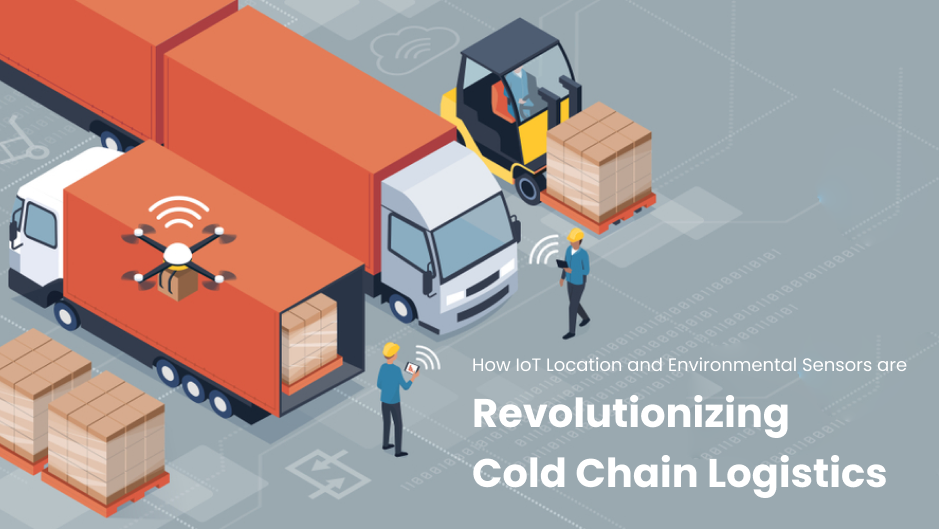How IoT Location and Environmental Sensors are Revolutionizing Cold Chain Logistics
In today’s world, supply chains have become increasingly complex and critical to the success of businesses. One of the most important aspects of supply chain management is cold chain logistics, which involves the transportation and storage of perishable goods under controlled temperature conditions. The cold chain logistics industry has been revolutionized by IoT location and environmental sensors, which have improved supply chain visibility, reduced waste, and enhanced product quality. In this article, we will discuss how IoT location and environmental sensors are revolutionizing cold chain logistics.
IoT location sensors are devices that are capable of tracking the location of goods in real-time. These sensors have become an integral part of cold chain logistics as they enable businesses to track their products from the point of origin to the point of delivery. With IoT location sensors, businesses can have real-time visibility into the movement of their products, which helps them to optimize their supply chain processes.

Environmental sensors are devices that are capable of monitoring and recording environmental conditions such as temperature, humidity, and light. These sensors have become an essential tool in cold chain logistics as they enable businesses to monitor the conditions under which their products are being transported and stored. By monitoring environmental conditions, businesses can ensure that their products are stored under the appropriate conditions, which helps to prevent spoilage and damage.
One of the most significant benefits of environmental sensors in cold chain logistics is that they can help to reduce waste. By monitoring environmental conditions, businesses can ensure that their products are stored under the appropriate conditions, which helps to prevent spoilage and damage. For example, if a shipment of fresh produce is stored at a too high temperature, the produce can spoil, and the entire shipment may need to be discarded. By using environmental sensors to monitor the temperature conditions, businesses can ensure that their products are stored at the appropriate temperature, which helps to reduce waste.
Another benefit of environmental sensors is that they can help to enhance product quality. By monitoring environmental conditions, businesses can ensure that their products are stored under the appropriate conditions, which helps to maintain product quality. For example, if a shipment of pharmaceuticals is exposed to high humidity, the quality of the medication may be compromised. By using environmental sensors to monitor humidity levels, businesses can ensure that their products are stored under the appropriate conditions, which helps to maintain product quality.
As the cold chain logistics industry continues to evolve, IoT location and environmental sensors are becoming more advanced and sophisticated. For example, some sensors are now capable of monitoring multiple environmental conditions simultaneously, such as temperature, humidity, and light. This allows businesses to monitor their products under a range of different conditions and take appropriate action to ensure that they remain safe and of high quality.
One of the challenges of implementing IoT location and environmental sensors in cold chain logistics is the cost. These sensors can be expensive, and businesses need to invest in the necessary infrastructure to support them. However, the benefits of these technologies can far outweigh the costs, especially in terms of reducing waste and improving product quality.
Another challenge is the complexity of integrating these technologies into existing supply chain processes. Businesses need to ensure that their IoT location and environmental sensors are compatible with their existing systems and processes, and that they can effectively analyze the data generated by these sensors. This requires a significant investment in IT infrastructure and data analysis capabilities.
Despite these challenges, the adoption of IoT location and environmental sensors in cold chain logistics is expected to continue to grow in the coming years. In fact, a recent report by Markets and Markets estimates that the global market for IoT sensors in the food and beverage industry will grow from $9.4 billion in 2018 to $22.2 billion by 2023, representing a compound annual growth rate of 18.6%.
In addition to IoT location and environmental sensors, other technologies are also being developed to enhance cold chain logistics. For example, blockchain technology is being explored as a way to improve supply chain visibility and traceability. By using blockchain, businesses can track the movement of their products in real-time and ensure that they are being transported and stored under the appropriate conditions.
Overall, the adoption of IoT location and environmental sensors in cold chain logistics is a game-changer for the industry. These technologies enable businesses to improve supply chain visibility, reduce waste, and enhance product quality, which are all critical factors in the success of the cold chain logistics industry. While there are challenges associated with the adoption of these technologies, the benefits are significant and are expected to drive continued growth in the industry in the coming years.
In conclusion, the adoption of IoT location and environmental sensors is revolutionizing cold chain logistics. These technologies enable businesses to track the location of their products in real-time, monitor environmental conditions, and take corrective action to prevent spoilage and damage. While there are challenges associated with the adoption of these technologies, the benefits are significant and are expected to drive continued growth in the industry in the coming years. As the industry continues to evolve, it will be interesting to see what new technologies and innovations emerge to further enhance cold chain logistics.”
